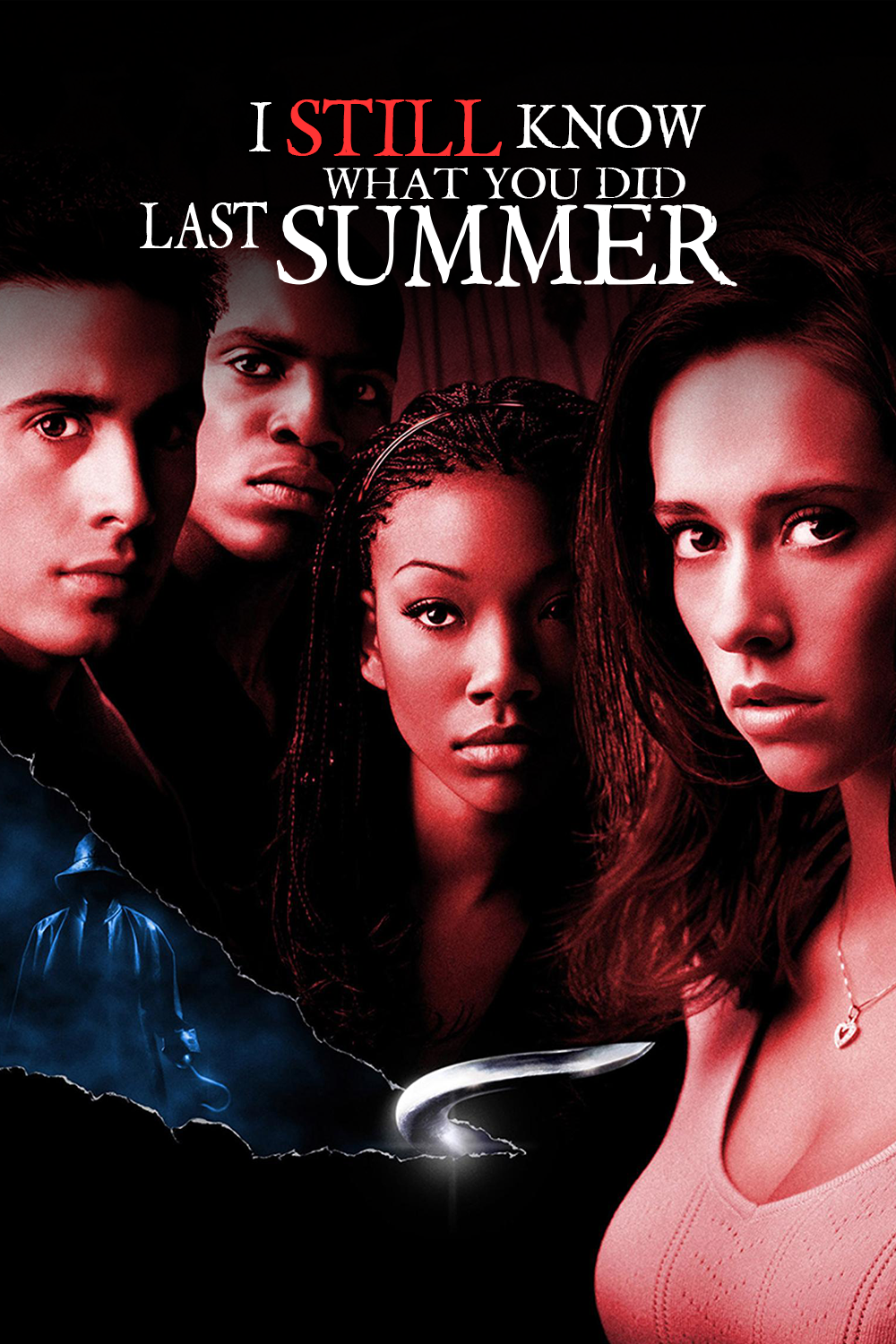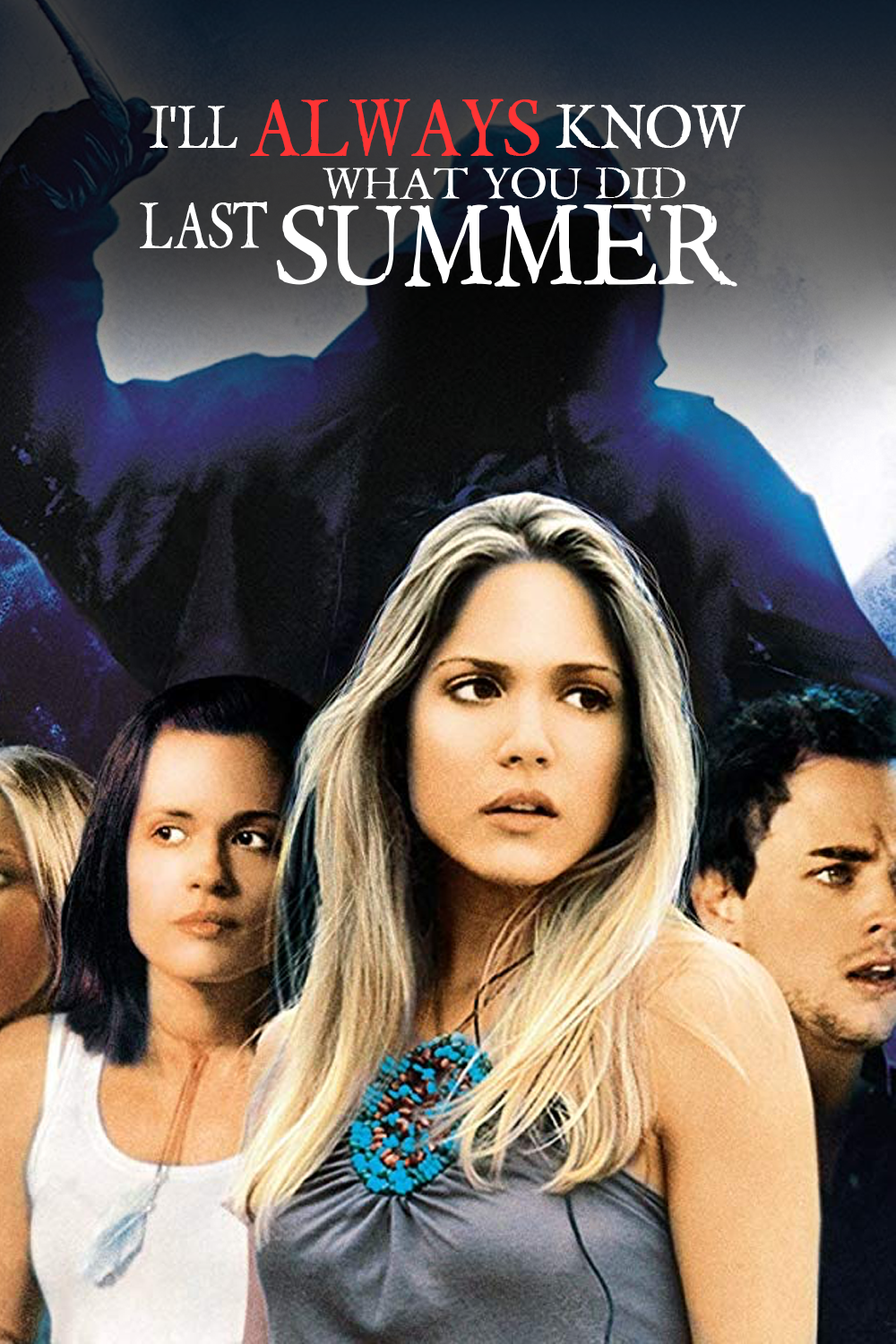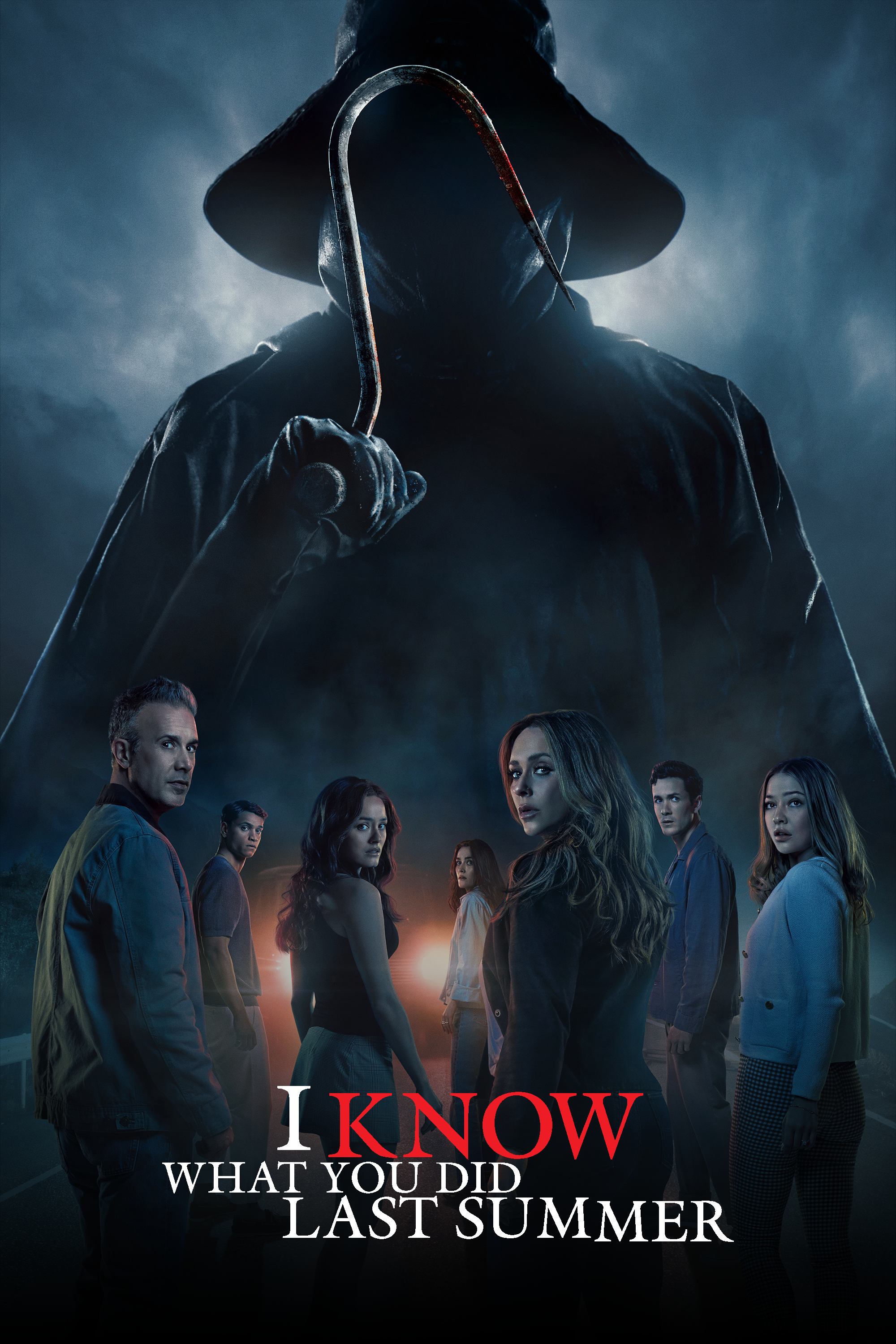Hooked Again: Everything You Need to Know About I Know What You Did Last Summer

With the return of Julie James and Ray Bronson on the horizon, it’s time to head back to Southport, North Carolina — the small coastal town where one bad decision started a legacy of blood, guilt, and hooks.
Whether you’re planning to watch the upcoming I Know What You Did Last Summer (2025), or just want to remember what happened to this franchise, this recap is for you. We’ll revisit the themes, the kills, the survivors, and what might still matter today.
I Know What You Did Last Summer (1997)
The story begins in 1997. Julie James, Ray Bronson, Helen Shivers, and Barry Cox are four teens enjoying drunken 4th of July festivities when they — unsurprisingly — hit a man with their car (accidentally, of course).
In a moment of panic, they make the only possible rational decision they could make in this circumstance: secret murder pact.
The group ultimately decides to dump the body and swear never to speak of it again. One year later, Julie receives a note with a message destined for titles:
“I KNOW WHAT YOU DID LAST SUMMER.”
Naturally, it doesn’t take long before their lives begin to unravel.
What makes this film so memorable isn’t just the hook-wielding killer. It’s the emotional weight behind the horror.
Julie is plagued by guilt and fear, struggling to hold herself together. Helen delivers one of the most iconic chase scenes in slasher history, a moment that still stands as a high point of the genre. Barry is all bravado and bad choices, and Ray... well, Ray tries.
What makes the guilt even harder to bear is what they believed they’d done. The group thought they had killed David Egan, who was a local man mourning the loss of his girlfriend, Susie, who died in a car accident the year before. They assumed his death was a second tragedy in a life already wrecked by grief…
…but David wasn’t the man they hit.
The man they struck was Ben Willis, a fisherman who had just murdered someone else David Egan out of revenge. Ben survives the accident and returns a year later to exact his own revenge on the teens. The film ends with Ben presumed dead, though not confirmed, leaving the door wide open for what came next.
Listen to our updated review of I Know What You Did Last Summer (1997)
Listen to our original review of I Know What You Did Last Summer (1997)
I Still Know What You Did Last Summer (1998)
The sequel finds Julie James trying to stitch herself back together, but trauma doesn’t disappear just because the killer does. A year after surviving Ben Willis’ brutal revenge, she’s in college and physically removed from Southport but still mentally trapped there. Her nights are full of panic and nightmares.
Her relationships are strained.
She can’t relax.
Can’t breathe.
Can’t forget.
Where the first film was about guilt, the second is about the aftermath of survival. Julie lived, but she’s far from okay. She walks around with the weight of what happened like it’s stitched into her skin. Her friends think she should be moving on, and Ray, the only other person who truly understands what happened, can’t bridge the distance that’s grown between them.
Enter Karla Wilson, Julie’s roommate and the kind of friend who sees the mess and stays anyway. When Karla wins a radio contest promising a luxury weekend getaway to a remote island resort, it feels like fate handing Julie a break.
A reset.
A chance to escape.
This film weaponizes the illusion of safety. The bright skies, the open waters, the promise of a vacation — it’s all just bait. It becomes clear treachery is afoot from the moment they arrive. The island is empty, the staff uneasy, and a storm cuts them off from the mainland.
What makes this story so effective, even in its more exaggerated slasher moments, is its ability to show trauma as something that doesn’t just follow you.
It hunts you.
Julie didn’t escape her past. She walked right into its next trap…and this time, the hook comes with reinforcements.
Will Benson, a mutual friend of Karla and Julie (and potential romantic competitor for Julie’s affections) reveals himself to be Ben Willis’ son. His name — as revealed in what is possibly the movie’s most worst line of dialogue — is literally “Will Ben’s Son.”
Behind the pun is something more unsettling: an inherited grudge. A child groomed for revenge. The sins of the parents don’t just linger — they recruit. Will’s betrayal fractures whatever trust Julie had left. Kindness, and even romance, have become weaponized against her.
Amid the chaos, Karla steps into a role rarely given proper credit in slasher sequels: the second final girl. She’s resourceful, brave, and refuses to go down easy. Her survival isn’t an accident. It’s earned.
Ray, meanwhile, begins the film on the fringes. He’s distanced himself from Julie, but something about the setup doesn’t sit right with him. After surviving an attempt on his life, he commandeers a boat and fights his way back to the island. It’s messy, heroic, and probably a little unhinged, but it brings the story full circle.
Ray and Julie started this together, and for now, they survive it together.
The movie ends with a familiar rhythm: Ben Willis is once again presumed dead, Julie and Ray make it out alive, and Karla walks away bruised but breathing. But just like before, the past doesn’t stay buried. It lingers, waiting to strike again. And by the time the credits roll, we know better than to trust the silence.
I Still Know trades in the same emotional currency as its predecessor, but it spends it differently. Instead of secrecy and guilt, it explores the long tail of trauma, the fragility of trust, and how easily fear can be repackaged as healing. It reminds us that surviving horror doesn’t make you stronger right away.
Sometimes, it just makes you tired…and sometimes, that’s all the killer needs.
Listen to our review of I Still Know What You Did Last Summer (1998)
I’ll Always Know What You Did Last Summer (2006)
The third installment in the franchise arrives nearly a decade after the original, but feels lightyears removed in tone, setting, and identity. I’ll Always Know What You Did Last Summer sheds the original cast, the coastal town of Southport, and even the grounded realism of the first two films. What remains is the franchise’s core conceit: an accidental death, a secret pact, and a hook-wielding killer who comes calling one year later. Here, that formula feels more like a ritual than a story.
The film opens with a group of teens pulling off a prank at a Fourth of July carnival in the fictional town of Broken Ridge, Colorado. They fake a Hook Man attack to scare the crowd, but the stunt goes sideways and one of their friends falls to his death. In a panic, the remaining four decide to cover up their involvement, swearing never to speak of it again.
Sound familiar?
One year later, the cycle begins again. Messages start appearing. A figure in a slicker begins stalking them. The hook returns.
At a surface level, this installment replicates the formula of the original, but feels emotionally hollow compared to the first film being steeped in psychological guilt and character-driven tension.
The characters are thinly drawn, the kills feel disconnected from the narrative, and the relationships lack the weight or chemistry of their predecessors. The movie doesn’t build on the legacy. It just imitates it — poorly.
What’s most striking about I’ll Always Know is the shift from slasher realism to urban legend horror. This shifts from a man coming back for revenge to a full-fledged ghost story.
The implication is that Ben Willis has become something supernatural, a cursed figure who returns to punish anyone who keeps deadly secrets. It reframes the fisherman not as a grieving father or vengeful killer, but as a force of morality and spirit of retribution.
This transformation could’ve worked if the film had committed to the concept and explored the mythology. Instead of fleshing out the idea, however, it treats the legend like a genre shortcut. There’s no emotional tie to Ben Willis. No reason to believe these teens are cursed beyond the franchise needing them to be. The supernatural angle isn’t earned. It’s pasted over the original framework like a mask.
Still, even in its weakest moments, I’ll Always Know touches on a few ideas that connect back to the heart of the franchise. The horror of being haunted not just by a killer, but by your own silence. The idea that guilt, once buried, only festers. The danger of playing with fear as entertainment, and not understanding its consequences. These threads exist, but the film never pulls on them hard enough to leave an impact.
For longtime fans, this entry often gets dismissed as non-canon, and for good reason. With no returning characters, no connection to Southport beyond the origin of Ben Willis, and no resolution that matters to the legacy characters, it feels more like a reimagining than a continuation. It borrows the title, the hook, and the moral, but loses the soul.
And yet, even in its lowest form, the story reminds us of one thing: the hook isn’t just a weapon. It’s a symbol of what we’ve buried, what we thought we got away with, and the fact that some secrets never stay dead.
Listen to our review of I'll Always Know What You Did Last Summer (2006)
What Still Matters in 2025
As we head into the 2025 legacy sequel, there are a few threads that matter most. Julie James and Ray Bronson both survived, but their experiences left them scarred. Julie, in particular, has spent years running from her trauma. Her return signals a reckoning...one that may force her to confront everything she buried.
Ben Willis may be gone, but his legacy is not. Whether we’re dealing with another relative, a copycat, or a town still haunted by the original sin, the hook remains symbolic. It’s the weight of guilt, the danger of secrets, and the cost of silence.
The franchise also hinted at a generational curse when it introduced Will Benson, Ben’s son. It’s possible the new film will build on that idea, exploring how trauma passes through families, how revenge doesn’t end with one generation, and how history repeats itself if no one is willing to break the cycle.
Ultimately, here’s what you really need to remember:
- The original killer, Ben Willis, was a fisherman driven by revenge.
- Julie and Ray are the only surviving original characters, and both are returning in the new film.
- Karla Wilson, played by Brandy, also survived the second movie and could still be out there.
- The third film veered into supernatural territory, but it’s not relevant the events of 2025.
What remains constant is the franchise’s core: guilt, silence, and the inescapable consequences of trying to bury the truth.
We’ve already covered the first three films on our podcast. If you’re rewatching or discovering them for the first time, you can listen to our full reviews, complete with behind-the-scenes trivia, breakdowns of the chase scenes, and our final verdicts on whether each film was a total joke, or totally killer.
From the docks of Southport to the storm-drenched beaches of the Bahamas, this series has always reminded us: someone always remembers..and in 2025, the hook comes back.
The new film hits theaters July 18, 2025, and whether you’re revisiting Southport or diving in fresh, you’re ready.






